Effortless Packed Lunch Ideas for Busy Professionals
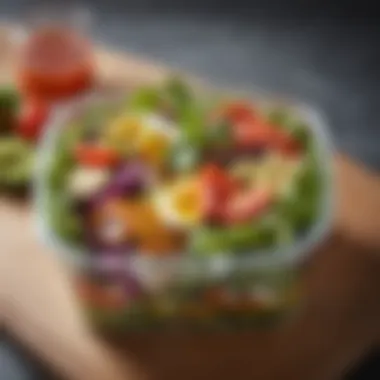
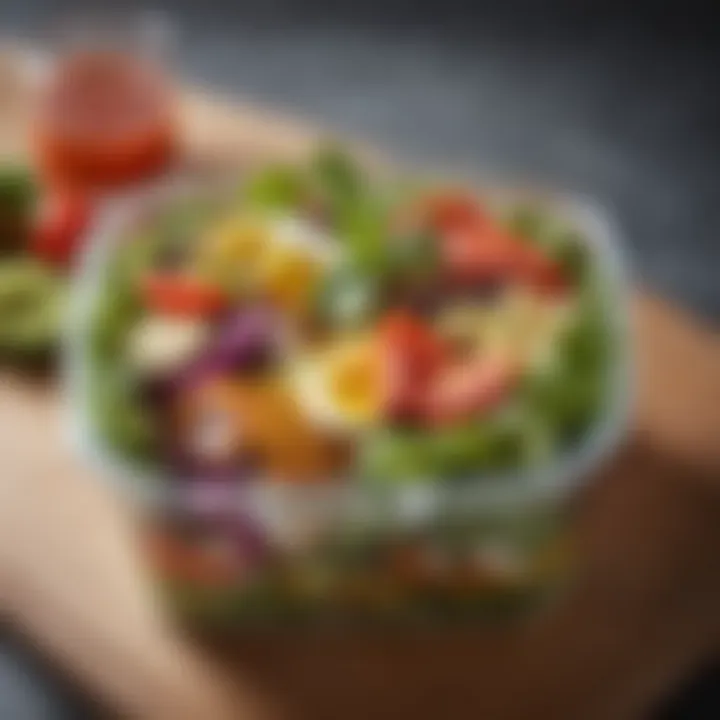
Intro
As the demands of modern work life intensify, the need for simple and nutritious packed lunch ideas becomes essential for maintaining energy and focus throughout the day. Preparing a meal that is both satisfying and convenient can enhance productivity and satisfaction, allowing professionals to navigate their busy schedules without compromising nutrition. This guide will delve into practical solutions, easy recipe ideas, and efficient meal prep strategies, eliminating the stress of lunch planning while keeping taste and nutritional balance at the forefront.
Recipe Overview
- Creative and Catchy Name: Vibrant Quinoa and Vegetable Bowl
- Portions Yielded: 2
- Time Required for Prep and Cook: 25 minutes
- Difficulty Level: Easy
- Main Ingredients: Quinoa, bell peppers, cherry tomatoes, cucumber, chickpeas, olive oil, lemon, and herbs
This Vibrant Quinoa and Vegetable Bowl is a perfect example of a packed lunch that delivers not only on flavor but also on healthy ingredients. It is quick to prepare and simple to customize based on personal preferences or dietary restrictions.
Step-by-Step Instructions
- Prep Ingredients: Start by rinsing 1 cup of quinoa under cold water. Dice 1 bell pepper, halve a cup of cherry tomatoes, and chop a cucumber. Rinse and drain a can of chickpeas.
- Cook Quinoa: In a medium saucepan, combine rinsed quinoa with 2 cups of water. Bring to a boil, then reduce heat and simmer for about 15 minutes until water is absorbed. Fluff with a fork.
- Mix Vegetables: In a large mixing bowl, combine the diced bell pepper, cherry tomatoes, chopped cucumber, and rinsed chickpeas.
- Dress the Bowl: In a small bowl, mix 2 tablespoons of olive oil, the juice of half a lemon, salt, pepper, and any preferred herbs. Pour this over the vegetables and mix well.
- Combine: Add the fluffed quinoa to the vegetable mixture and stir gently until everything is combined well.
- Storage: Divide the mixture into two containers, ensuring they are sealed tightly for easy transport.
Time-Saving Strategies: Preparing the quinoa in batches can save time. Additionally, using pre-chopped vegetables or frozen varieties can expedite the process.
Nutritional Information
- Total Calorie Count per Portion: Approximately 370 calories
- Breakdown:
- Proteins: 12g
- Fats: 18g
- Carbohydrates: 44g
In addition to being low in calories, this dish is rich in fiber and packed with vitamins from colorful vegetables. The chickpeas provide excellent protein and promote satiety, while healthy fats from olive oil assist in the absorption of essential nutrients.
Quick Cooking Tips
- Utilize a rice cooker to prepare quinoa effortlessly. It simplifies the cooking process while ensuring consistent results.
- Multitask by chopping vegetables while the quinoa cooks.
- For a variation, try replacing chickpeas with lentils or adding feta cheese for extra flavor. Choosing whole grain versions of grains enhances nutritional value.
Related Recipes & Variations
- Consider preparing a Mediterranean Pasta Salad with similar vegetables and whole wheat pasta for variety.
- Experiment by swapping quinoa with farro or barley for new texture and taste.
- Adapt for dietary needs by ensuring gluten-free grains are used or adding more plant-based proteins.
Packed lunches do not have to be complex. A little creativity can turn simple ingredients into nutritious meals that fuel your workday.
Understanding the Importance of Packed Lunches
Packed lunches are often seen as a simple solution for meals during work hours. However, their significance extends beyond just convenience. Understanding the importance of packed lunches revolves around the benefits they offer in nutrition, finances, and customization.
Eating packed lunches allows individuals to make healthier choices tailored to their dietary needs. Home-cooked meals typically include fresher and less processed ingredients compared to takeout options. As a result, they can greatly contribute to one's overall well-being.
Financial considerations are also a crucial element in this discussion. Preparing meals at home tends to be more cost-effective than frequent dining out. Thus, individuals can easily monitor their expenses while enjoying delicious and nutritious meals.
Finally, the flexibility of packed lunches enables customization. This covers a range of dietary needs such as vegan, gluten-free, or low-carb options, making it easier to accommodate various preferences. In summary, packed lunches serve a multifaceted role in promoting health, saving money, and offering personalization.
Health Benefits of Home-Cooked Meals
Nutritional Control
Nutritional control is a vital aspect of home-cooked meals. By preparing your own lunches, you can choose ingredients that fit your nutritional goals more closely. For instance, you can eliminate excess sugars and fats that are often found in pre-packaged foods. This element gives you the power to create meals that suit your specific dietary requirements.
One key characteristic of nutritional control is ingredient choice. Opting for fresh vegetables, whole grains, and lean proteins can make a significant differene in the healthiness of your meals. The unique feature of this control is that it allows individuals to maintain their health while still enjoying satisfying meals.
Portion Management
Portion management is another effective technique that comes along with packed lunches. When you prepare your meals at home, you can better regulate the quantities of food you consume. This helps prevent overeating, which can be a problem with restaurant meals or fast food.
The significant aspect of portion management is that it encourages mindfulness in eating. By separating individual portions, you avoid the traps of buffet-style dining or large servings. Additionally, this practice can help maintain a healthy weight, reducing the chances of health complications.
Reduced Consumption of Processed Foods
Reducing processed foods is a prominent advantage of choosing home-cooked lunches. Most processed foods come loaded with preservatives, artificial ingredients, and unhealthy fats. By avoiding these, you can improve the nutritional quality of your meals significantly.
One important characteristic of this reduced consumption is the increase of whole ingredients in your diet. With more fruits, vegetables, and grains, the health benefits are evident. The unique aspect is that eliminating processed foods not only enhances your nutrition but also fosters better energy levels throughout the day.
Financial Advantages
Cost Savings Compared to Eating Out
Cost savings is a strong argument in favor of packing lunches. Dining out can lead to a significant expense over time, whether it be daily lunches or frequent coffee breaks. By making packed lunches, you spend considerably less while still enjoying diverse and nutritious meals.
The key aspect to highlight is the sheer difference in price. A homemade meal can often cost a fraction of what you would pay at a restaurant or café. Furthermore, it provides a unique opportunity to budget effectively, making it easier to save money.
Minimizing Food Waste
Minimizing food waste is another important consideration regarding packed lunches. By preparing your meals, you have greater control over portion sizes and ingredients, leading to less leftover food being tossed away. This contributes positively to environmental sustainability.
The key feature here is the efficiency in food management. You can repurpose leftovers into new meals or utilize ingredients fully, rather than letting them spoil. This ability to minimize waste not only saves money but also promotes responsible consumption.
Leveraging Bulk Ingredients
Leveraging bulk ingredients is advantageous for meal preparation and financial savings. When cooking at home, buying ingredients in bulk can reduce costs significantly. Items like rice, beans, or grains can often be purchased at lower prices per serving.
This practice's significant advantage is that it allows for meal diversity without breaking the bank. The unique feature is that bulk purchases lead to various meal combinations over the week, reducing the monotony of eating the same thing daily.
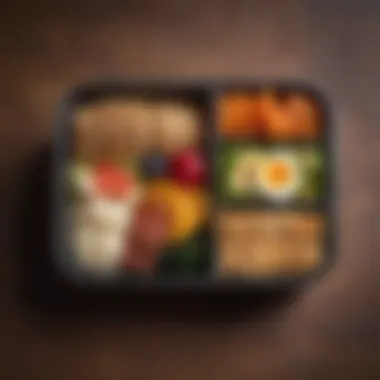
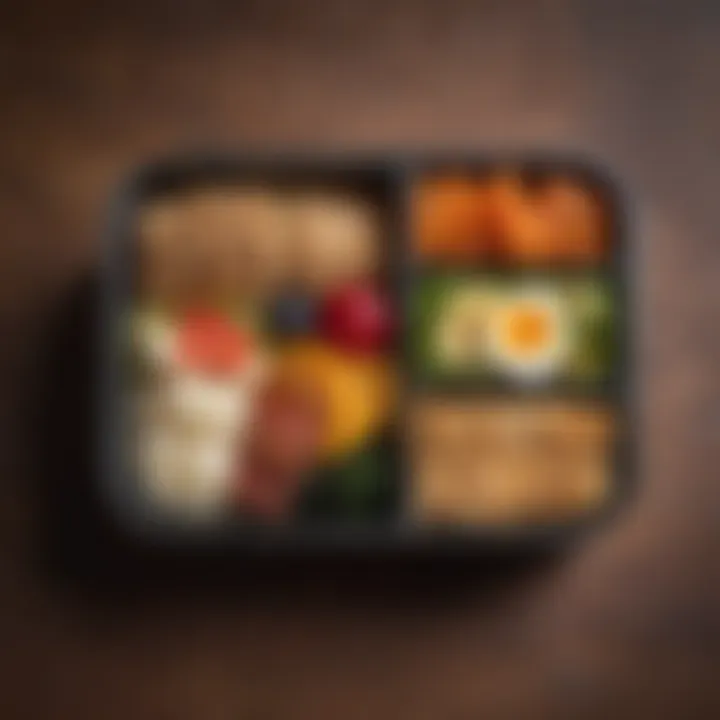
Customization for Dietary Preferences
Vegan and Vegetarian Options
Vegan and vegetarian options are essential components for many individuals today. Creating meals based on plant ingredients not only meets specific dietary preferences but also can often boost overall health. By integrating more whole foods, you can create filling and flavorful meals.
This aspect stands out as being versatile and satisfying. The unique impression is that these options can reignite one's passion for cooking, leading to an exploration of new flavors and cuisines.
Gluten-Free Alternatives
Gluten-free alternatives serve those who are sensitive to gluten or have celiac disease. When packing lunches, it is important to find substitute ingredients to avoid complications. Many grains such as quinoa or rice can be used to create delicious and safe meals.
The key component of gluten-free meals is variety. With a bit of research, one can discover numerous recipes that mitigate the absence of gluten while still retaining taste. Some might find the process of seeking these alternatives refreshing and educational.
Low-Carb and Keto-Friendly Meals
Low-carb and keto-friendly meals have gained popularity among those following specific diet plans. It is possible to create satisfying lunches without relying on high-carb ingredients. Instead, focus on proteins and healthy fats to build nutrient-dense meals.
This aspect is beneficial for individuals looking to reach weight loss or maintenance goals. A unique focus is that low-carb meals can be quite filling, helping to curb hunger while still enjoying a variety of flavors.
Ultimately, understanding the importance of packed lunches allows individuals to take proactive steps toward better health, economic efficiency, and dietary satisfaction.
KeyConsiderations When Packing Lunches
Packing a lunch requires thoughtful consideration. It's not simply about putting food in a container. Rather, it involves understanding a few key elements to create a nourishing and satisfying meal that meets various needs throughout one's busy workday. Making the right choices can improve overall health and make the process efficient.
Balancing Nutrition
Incorporating balanced nutrition into packed lunches is paramount. It ensures that individuals receive the essential nutrients their bodies require for peak performance during the day. A balanced lunch includes not just any food, but a good mix of proteins, carbs, and fats.
Proteins, Carbs, and Fats
Proteins, carbohydrates, and fats are the three macronutrients that make up our diets. Each serves specific roles supporting body functions. Proteins help build and repair tissues. Carbohydrates act as the body's main energy source. Meanwhile, fats are crucial for absorbing certain nutrients.
Each macronutrient brings important benefits. Without enough protein, one may feel weak during the day. A lack of carbohydrates leads to low energy levels. Therefore, understanding the right balance is crucial for maintaining energy and performance.
Incorporating Fruits and Vegetables
Incorporating fruits and vegetables boosts lunch value. These foods add fiber, vitamins, and antioxidants that support overall health. Fruits and vegetables are low-calorie options. They make meals more filling without excessive calories. Their inclusion also helps manage hunger, keeping one energized for tasks.
However, it is important to choose a variety of colors and types. This way, one maximizes nutrient intake. Prepackaged fruits, for example, can be less healthy due to added sugars. Hence, fresh options are often the best.
Understanding Caloric Needs
Understanding one's particular caloric needs is crucial for effective meal planning. Every individual's daily energy requirements differ based on factors like age, weight, and activity level. Such awareness prevents either overeating or under-eating, both of which can lead to health issues.
By adjusting portion sizes and choosing nutrient-dense foods, individuals can create meals that sustain them without consuming too many empty calories. A little research or consultation may help one pinpoint their caloric needs, which is essential for effective lunch planning.
Time-Efficient Preparation
Efficient preparation methods are also a vital aspect of packing lunches. This reduces stress on busy mornings while ensuring that nutritious options are available. Investing time in effective meal prep methods is beneficial.
Batch Cooking Strategies
Batch cooking involves preparing large quantities of food in one session. This strategy allows for cooking multiple meals at once. The result is a selection of ready-to-eat lunches throughout the week. Not only does this save time daily, but it also promotes reducing food waste by utilizing bulk items effectively.
With batch cooking, one can create more complex dishes that might otherwise take too long to prepare singly. Soups, casseroles, and stir-fries are great candidates for batch cooking, as they often taste better the next day.
Prepping Ingredients Ahead of Time
Prepping ingredients ahead of time helps streamline making meals. Chop vegetables, cook grains, or marinate proteins for quick assembly during busy days. When ingredients are ready to go, one can prepare meals in mere minutes.
An organized approach can make a significant difference. One can consider small containers to store prepped items, allowing for easy access during the week. This not only simplifes lunch packing, it also encourages healthier choices by having wholesome options available.
Utilizing Leftovers Effectively
Utilizing leftovers is an easy way to minimize food waste while ensuring tasty meals. If one has cooked a hearty dinner, packing leftover portions for lunch is a simple solution. It allows for variety without additional cooking time.
Planning dinners with leftovers in mind, such as making extra rice or grilled vegetables, can cut down preparation time throughout the week. This practice also speaks to financial benefits, as it leverages previously purchased foods rather than letting them go unused.
Choosing the Right Storage Solutions
Selecting appropriate storage methods is equally essential. The right containers preserve meal quality and ensure fresh flavors upon lunch arrival.
Containers for Different Food Types
Choosing containers based on food type is key for maintaining freshness. For sauces and salads, leak-proof containers are necessary, while bento boxes may offer compartments for different foods. This organization prevents sogginess and retains flavors.
Investing in sturdy containers also encourages packing meals in advance. A variety of sizes will accommodate different meal components, ensuring a balanced lunch every day.
Insulated Options for Temperature Control
Insulated containers are beneficial for keeping meals hot or cold. Soups or stews can be packed warm, ensuring they remain appetizing until lunchtime. Alternatively, salads packed with fresh ingredients are best when kept cool.


Using vacuum-sealed insulated containers can sometimes cost more. However, their ability to maintain food temperatures almost all day is typically worth the investment, especially for those who rely on well-prepared meals.
Eco-Friendly Packaging Choices
Lastly, selecting eco-friendly packaging is vital for sustainably-minded individuals. Using recyclable materials aligns with current efforts to reduce waste. Choosing reusable bags or biodegradable containers will benefit not just individual lunch plans, but also the environment.
An eco-conscious approach also opens options for cost savings in the long run. Though initial purchase prices may be higher, the reduction in single-use packaging can lead to lower overall spending on lunch supplies.
Quick Lunch Ideas: No-Cook Solutions
The concept of no-cook lunch ideas is vital for busy professionals aiming to maintain a healthy diet while juggling their work responsibilities. These options offer quick, nutritious meals that require minimal time in the kitchen. By avoiding cooking, individuals save time during their mornings, allowing for a more efficient start to the day. Additionally, no-cook meals often rely on fresh ingredients, which might provide better nutritional value compared to fast food or highly processed options. The emphasis on simple assembly rather than elaborate preparation keeps the lunch experience straightforward and enjoyable.
Salads and Grain Bowls
Easily Assembled Ingredients
Easily assembled ingredients play a significant role in simplifying meal prep. This aspect ensures that busy individuals can create a nutritious meal without extensive cooking techniques or tools. Using pre-packaged greens, cooked grains like quinoa, and various toppings allows for a quick assembly process. The key characteristic of this approach is its focus on convenience, making it a popular choice for those seeking efficiency in their lunch preparations. Easily assembled ingredients allow one to mix and match, providing variety each day without much effort. However, it is crucial to ensure freshness when using these ingredients, as they can spoil quickly.
Dressing and Toppings to Enhance Flavor
Adding dressing and toppings to salads or bowls significantly enhances flavor. These elements can transform a basic meal into a delightful experience. A wide array of dressings, from vinaigrettes to creamy options, makes it simple to tailor lunches to personal preferences. The unique feature of incorporating various dressings is that they not only add taste but can also boost the nutritional profile. For example, adding a tahini dressing can introduce healthy fats and essential nutrients. Yet, one must be cautious about portion control with dressings high in calories.
Sandwiches and Wraps
Creative Combinations
Creative combinations are essential for maintaining excitement in packed lunches. Blending different ingredients like meats, cheeses, and vegetables can yield numerous flavor profiles. The strength of this concept lies in customization; it allows for a personal touch to each sandwich or wrap. This adaptability means more enjoyable meals, which is necessary for sustained interest in packed lunches. However, the effort required to be consistently innovative may pose a challenge for some, as repeating similar combinations can lead to meal fatigue.
Using Spreads for Added Texture
Using spreads for added texture enriches the lunch experience. Spreads can range from hummus to more classic options like mayonnaise or pesto, influencing not only flavor but also mouthfeel. This element's benefit is its ability to bind ingredients together, making each bite satisfying. The unique feature of spreads is their versatility; a single spread can enhance a range of sandwiches or wraps. Nonetheless, one must be mindful of the nutritional content in spreads, as some options can be calorie-dense.
Cheese and Charcuterie Packs
Selecting Cheeses and Cured Meats
Selecting cheeses and cured meats is a crucial aspect of creating effective cheese and charcuterie packs. The combination creates a satisfying and flavorful lunch that requires no cooking. Key characteristics include variety and diversity in textures and tastes. This choice is beneficial because it allows for an aesthetically pleasing arrangement of food, which can enhance the overall enjoyment of the meal. However, care should be taken with portion sizes, as cured meats are often higher in sodium and fat.
Adding Fruits and Nuts for Balance
Adding fruits and nuts for balance makes cheese and charcuterie packs more nutritious. This aspect contributes essential vitamins and minerals, complementing the fats and proteins from the cheese and meats. The inclusion of fresh fruits provides a refreshing contrast to the richness of the meats, while nuts add healthy fats and a satisfying crunch. This unique feature is advantageous as it creates a well-rounded meal that satisfies various taste preferences. However, portion sizes should be considered, as nuts can be calorically dense.
Hearty Lunch Ideas: Minimal Cooking Required
Hearty lunch ideas are essential for individuals seeking fulfilling meals with minimal cooking effort. These options provide sustenance and flavor, aligning well with the busy schedules faced by working professionals. Preparing meals that require little time and effort contributes to stress reduction, allowing individuals to focus their energies elsewhere. Hearty packed lunches, such as casseroles, soups, and stir-fries, offer warmth and nourishment, making them particularly appealing during colder months. The emphasis on minimal cooking doesn't compromise nutrition; rather, it ensures that incorporating solid meals into one’s daily routine is manageable and enjoyable.
Casseroles and One-Dish Meals
Casseroles and one-dish meals present an efficient way of preparing hearty lunches. They combine various ingredients into a single dish, which simplifies both preparation and cleanup.
Easy Assembly and Baking Techniques
The approach of easy assembly and baking techniques makes it a practical choice for busy days. This method allows for a straightforward layering of ingredients, ranging from grains and proteins to vegetables. The key characteristic of this technique is its time-saving nature. Instead of multiple pots and pans, everything can be consolidated into one dish. Thus, one can simply prep the ingredients in advance and then bake them when ready. This unique feature not only reduces cooking time but also ensures that flavors meld together beautifully during the baking process. However, some may find that the lack of searing or precise cooking techniques might affect the dish's texture.
Recipes for Leftover Utilization
Utilizing leftovers effectively is a fundamental concept in meal prep, especially for casseroles. Recipes designed for leftovers help minimize food waste and optimize resources.
The important aspect of these recipes lies in their versatility. Leftovers from previous meals can often be repurposed into delicious casseroles, enhancing flavor while conserving time and energy. This popular approach is beneficial because it allows individuals to creatively use what they already have at hand. The unique feature of this concept is its capacity to transform ingredients that might otherwise go uneaten into revitalizing dishes. Yet, creating new recipes from leftovers demands a certain level of creativity that not all may possess.
Soup and Stews
Soups and stews deliver flexibility and warmth, making them ideal for packed lunches. Married with their minimal cooking requirement, these meals can be prepared in bulk and saved for future lunches.
Preparing in Bulk
Preparing in bulk is a wise strategy in meal prep, especially for soups and stews. This method highlights efficiency, allowing for large batches to be made at one time, which can be portioned and stored for later use. The key characteristic here is the ability to nourish oneself over several days without daily effort. This also supports the idea of minimizing time spent cooking during busy workweeks. Consequently, individuals can dedicate more time to other activities. The unique feature is that the flavors of soups and stews often intensify upon reheating, enhancing the meal experience. However, one may need to be cautious about storing these meals for too long to prevent spoilage.
Portioning for Daily Use
Portioning meals correctly for daily use ensures balanced nutrition and helps maintain control over serving sizes. This practice not only helps in managing caloric intake but also encourages a structured eating routine.
The notable aspect of portioning is that it allows for dietary adjustments to be made easily. For instance, one can prepare several portions and customize them according to personal or family preferences. This is a beneficial method, especially for those focusing on specific dietary goals. The unique feature is that it introduces variety into everyday lunches, preventing monotony. However, one must ensure that each portion retains the necessary balance of nutrients.
Stir-Fries and Skillet Meals
Stir-fries and skillet meals bring a quick and flavorful option to the table. They require minimal cooking time while offering myriad combinations that can satisfy varying tastes.
Quick Cooking Methods
The hallmark of quick cooking methods is speed without sacrificing taste. Both stir-fries and skillet meals can be prepared in a matter of minutes by utilizing high heat and minimal oil. This technique allows meals to be cooked rapidly, preserving the integrity of vegetables and proteins, while providing a satisfying texture. The key characteristic is the ability to get a complete meal on the table in under half an hour. This beneficial aspect is crucial for those who have busy workdays. However, it is important to monitor cooking closely to avoid overcooking, which can diminish the nutritional value and flavor.
Choosing the Right Vegetables and Proteins
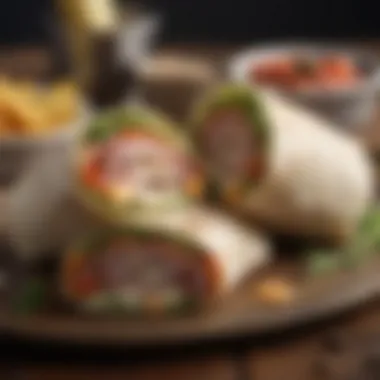
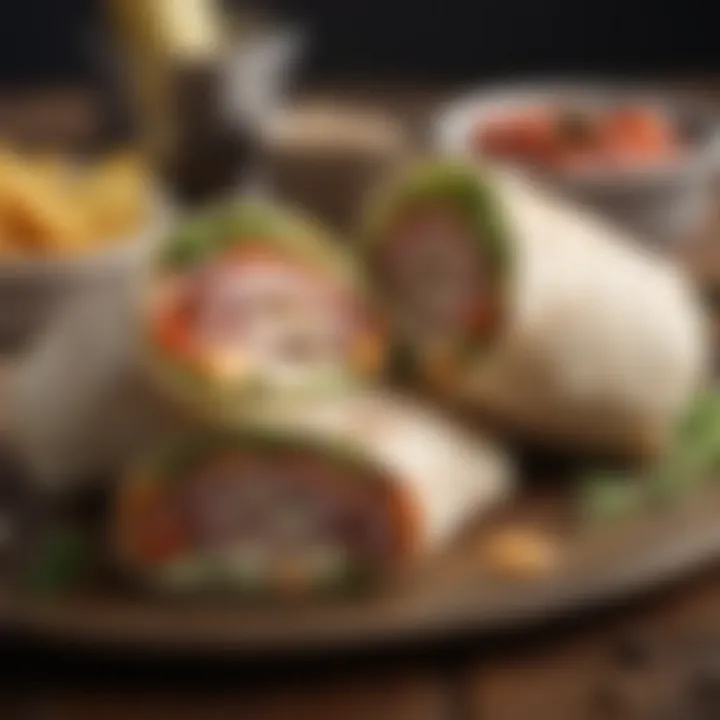
Selecting the appropriate vegetables and proteins is decisive in crafting a successful stir-fry or skillet meal. The right choices enhance the dish's nutritional profile and flavor complexity.
The core aspect lies in the coloring and flavor variety provided by different vegetables. For proteins, options like chicken, shrimp, or tofu can all contribute to a rich meal. The benefit of this diversity ensures that there is something for everyone, catering to various dietary preferences. The unique feature of this selection process is that it allows chefs to almost create a new dish each time, depending on seasonal availability or personal taste. However, care must be taken to manage cooking times and techniques to ensure that all ingredients complement each other well.
Incorporating International Flavors
Incorporating international flavors into packed lunches adds variety and excitement to daily meals. It allows individuals to explore different cultures through their cuisine, turning mundane lunch breaks into enjoyable culinary experiences. By integrating diverse flavors, lunches become more than just meals; they transform into an opportunity for gastronomic discovery, engaging the palate while providing essential nutrients.
Variety in flavors is beneficial for several reasons. It prevents repetitive meals, ensuring that lunch does not become a dull affair. Additionally, international dishes often emphasize fresh ingredients, which can encourage healthier eating habits. Each cuisine comes with its unique set of ingredients and cooking methods, which can inspire creativity in meal preparation.
Mediterranean-Inspired Lunches
Falafel and Hummus Wraps
Falafel and hummus wraps are a well-loved aspect of Mediterranean cuisine. This combination offers a satisfying meal that is rich in plant-based proteins and healthy fats. Falafel, made predominantly of chickpeas, provides essential nutrients while being filling. Hummus, typically made from blended chickpeas, tahini, lemon juice, and garlic, complements falafel with its creamy texture and tangy flavor.
A key characteristic of falafel and hummus wraps is their adaptability. They can be customized to include various salad greens, tomatoes, cucumbers, or pickles, enhancing both flavor and nutritional content. This flexibility makes them a beneficial choice for busy professionals who may have dietary restrictions or preferences.
The unique feature of falafel wraps is their ability to be prepared in advance. The falafel can be made in bulk, and the wraps can be assembled quickly in the morning, making them manageable for a packed schedule. However, one consideration is that falafel can become soggy if kept in a humid environment, so proper storage is crucial.
Tabbouleh and Pita Combinations
Tabbouleh and pita combinations offer a fresh, vibrant alternative in packed lunches. Tabbouleh is a parsley salad that typically contains tomatoes, mint, and bulgur wheat, dressed with olive oil and lemon juice. This salad is light, refreshing, and packed with nutrients, making it an appealing option for lunch.
A significant advantage of tabbouleh is its emphasis on fresh herbs and vegetables. This quality not only enhances flavor but also promotes overall health, making it a popular choice among health-conscious individuals. Its bright colors and textures add visual appeal, enticing those who might find other lunches uninviting.
The unique aspect of this dish is its straightforward preparation. Tabbouleh can be made ahead of time, allowing flavors to meld, enhancing its taste. The only downside might be that the bulgur wheat can absorb moisture, affecting the texture if left too long. Therefore, it’s best served promptly or stored separately from the pita and other ingredients.
Asian Influence on Lunch Ideas
Sushi Rolls and Rice Paper Wraps
Sushi rolls and rice paper wraps bring a unique flair to packed lunches. Sushi, well-known in Japanese culture, traditionally consists of vinegared rice combined with seafood, vegetables, and seaweed. Rice paper wraps, common in Vietnamese cuisine, are versatile and allow for various fillings and flavors.
The key characteristic of sushi rolls is their balance of flavors and textures. They combine savory, sweet, and umami elements, creating complex bites. These wraps are beneficial for those who appreciate intricate tastes and have the time to prepare them in advance.
A distinct feature of sushi rolls and rice paper wraps is that they can be filled with almost any ingredient, from fresh fish to vegetables and tofu. This versatility allows for catering to diverse dietary preferences. However, sushi rice needs careful handling to maintain its quality, and that can be a drawback for hurried meal preps.
Asian-Inspired Salad Combinations
Asian-inspired salad combinations, such as those featuring sesame ginger dressing or miso vinaigrette, are refreshing and allow for variety in packed lunches. These salads often include ingredients like cabbage, carrots, edamame, and various seeds, providing a crunchy texture and nutrient-dense profile.
A standout feature of these salads is the vibrant flavors achieved through dressings. They can be tailored to individual tastes, whether one prefers spicy, sweet, or tangy flavors. This customization provides a beneficial aspect, appealing to a broader audience while encouraging explorations of flavors.
However, a consideration when preparing these salads is the potential for wilting ingredients if stored for too long. Therefore, keeping dressing separate until just before eating can preserve texture and freshness.
Latin American Flavors
Empanadas and Tortilla Wraps
Empanadas and tortilla wraps present a hearty option for packed lunches. Empanadas are pastry pockets filled with various ingredients, like meats, vegetables, or cheeses. They are portable and can be eaten warm or cold, making them versatile for a lunch setting.
A key characteristic of empanadas is their adaptability. They can showcase different fillings and spices depending on regional influences. Their preparation can vary from baking to frying, allowing individuals to select a method that fits their nutritional preferences. Their portability is an advantage, especially for people on the go who need convenient meal options.
However, despite their many benefits, empanadas can be heavier than other lunch options. It’s essential to balance them with lighter sides or salads to ensure a well-rounded meal.
Bean and Rice Bowl Inspirations
Bean and rice bowl inspirations reflect the essence of Latin American cuisine. These bowls often feature beans, rice, vegetables, and various seasonings, providing a filling and nutritious meal. They are particularly beneficial for their high protein and fiber content, contributing to satiety.
A unique feature of these bowls is their ability to be customized to individual preferences. Ingredients can be mixed and matched, catering to different dietary needs, such as vegetarian or vegan options. This versatility makes them appealing for packed lunches, particularly when time is limited.
That said, freshness is a crucial consideration. The quality of ingredients can diminish if the bowls are prepared too far in advance, especially when adding perishable toppings like avocado. Ensuring that fresh elements can be adde before serving is essential for maintaining flavor and appeal.
Final Thoughts on Meal Preparation
Meal preparation is a crucial element in ensuring that packed lunches are not only convenient but also enjoyable and nutritious. This article has provided insights into various aspects of preparing simple packed lunches for work that are enjoyable and meet dietary preferences. By putting thought into meal preparation, individuals create meals that suit their taste and nutritional needs, making it easier to stick to healthy eating habits during hectic work weeks.
Creating a Weekly Lunch Plan
Setting Realistic Goals
Setting realistic goals is essential for successful meal preparation. Individuals often have busy schedules filled with work and personal commitments. Thus, feasible goals encourage adherence to meal planning. Realistic goals can range from preparing three lunches a week to ensuring a varied menu that includes simple recipes. This approach minimizes stress and leads to a more consistent habit of packing lunches. Moreover, identifying the time available for meal prep helps individuals make a better decision about the number of meals they can prepare effectively.
Adjusting Based on Feedback
Adjusting based on feedback is important for continuous improvement in meal preparation. After trying out different recipes and combinations, feedback from taste tests or even colleagues can refine future meal choices. This iterative process allows individuals to identify what works best for their taste preferences or nutritional goals. It encourages flexibility, making it easier to stick to the meal plan long-term. Moreover, incorporating suggestions from family or friends creates an open dialogue about culinary creativity, enhancing the meal preparation experience.
Tips for Sustained Motivation
Tracking Progress and Enjoyment
Tracking progress and enjoyment can significantly enhance motivation in meal preparation. Keeping a simple journal or a digital log of meals made can provide a sense of accomplishment. Additionally, noting which recipes are favorites can help individuals focus on enjoyable options. By setting small, achievable milestones, it reinforces the habit of meal prep and delights in the process. It can also encourage exploration of new ingredients and techniques, easing any feelings of monotony that might arise over time.
Exploring New Recipes Periodically
Exploring new recipes periodically ensures that meal preparation does not become predictable or stale. Trying diverse cuisines or incorporating seasonal ingredients keeps meals exciting. This approach encourages culinary experimentation, which not only nurtures creativity but also helps expand one’s culinary repertoire. By dedicating time to search for and test new recipes, meal preppers can maintain a flow of innovation in their packed lunches, providing both nutrition and interest to their daily diet.
Meal prep is a journey, not a destination. Each meal is an opportunity for exploration and satisfaction.







